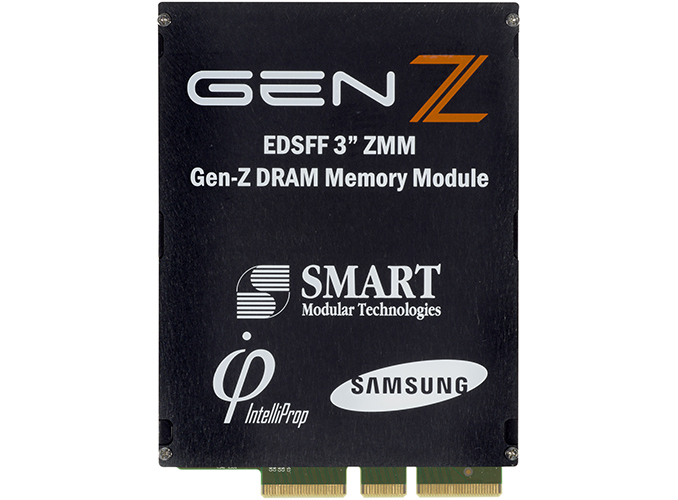SMART Modular Shows Off 256 GB Gen-Z Memory Module
by Anton Shilov on August 15, 2019 1:00 PM EST- Posted in
- Memory
- Samsung
- DDR4
- Gen-Z
- EDSFF
- Smart Modular
- IntelliProp

SMART Modular this month demonstrated one of the industry’s first prototypes of a EDSFF 3-inch DDR4 Gen-Z memory module. The ZMM supports advanced functionality enabled by the new interface and offers throughput akin to that offered by today’s DDR4-4000 memory modules.
SMART Modular’s 256 GB ZMM uses Samsung’s 32 Gb 4-high DDR4 DRAM devices as well as IntelliProp’s Gen-Z Mamba memory controller ASSP, which supports multiple access semantics, including byte and block addressable DRAM access, in-band configuration, and access key/region key memory isolation opcodes in a bid to simplify memory access needed to handle emerging data-centric workloads. The controller features 16 Gen-Z lanes with 25 Gbps PHY as well as 400 Gbps aggregate performance. The chip requires up to 20 W of power, so it needs proper cooling.
The Gen-Z module from SMART Module comes in SNIA’s 3-inch 4C SFF-TA-1008/9 form-factor, and offers a 30 GB/s bandwidth along with 400 ns deterministic access latency.
The 256 GB ZMM was demonstrated in rack servers designed by Dell and Hewlett Packard Enterprise specifically to test Gen-Z interconnection.
The showcase of a 256 GB Gen-Z ZMM by a well-known supplier of memory and storage solutions with two makers of servers indicates that the industry is getting ready for a roll-out of Gen-Z products in the future. What remains to be seen is when exactly SMART Modular and its partners will be ready with commercial Gen-Z modules and platforms.
Related Reading:
- Gen-Z Interconnect Core Specification 1.0 Published
- Hot Chips 31 (2019) Programme Announced: Zen, Navi, POWER, Lakefield, Gen-Z, Turing, Lisa Su Keynote
- Gen-Z Consortium Formed: Developing a New Memory Interconnect
- SMART Modular Announces 32 GB SO-DIMMs for Extreme Environments
- SMART Modular HRS-T5E: A Ruggedized SATA SSD with AES-XTS 256
Source: SMART Modular










15 Comments
View All Comments
azfacea - Thursday, August 15, 2019 - link
wtf ? ddr4 ? edsff ? "gen-z lanes"p1esk - Thursday, August 15, 2019 - link
EDSFF: Enterprise and Datacenter SSD Form Factor https://www.anandtech.com/show/13218/ssd-form-fact...Gen-Z: new interconnect standard https://genzconsortium.org/about-us/gen-z-technolo...
DDR4: really?
azfacea - Thursday, August 15, 2019 - link
i know about EDSFF and DDR4. i meant what the fuck is ddr4 doing in EDSFFDanNeely - Thursday, August 15, 2019 - link
ramdisk?CheapSushi - Tuesday, August 20, 2019 - link
The vast majority of drives have DRAM on them...Santoval - Thursday, August 15, 2019 - link
400 ns access latency? Why so high? Is high latency the cost of the high density or is the extra latency due to Gen-Z protocol's high overhead? The 30 GB/s of bandwidth is also rather low. Is the "30" number a typo? That 400 Gbps of total bandwidth mentioned above is equivalent to 50 GB/s of bandwidth, not 30 GB/s. Is there a protocol limit to how many of these modules can be used at the same time or is the limit imposed by the available slots of the server motherboard?CaedenV - Thursday, August 15, 2019 - link
is .4ms considered 'high latency' for storage these days? Still seems faster than most SSDs on the marketEmotiveElectron - Thursday, August 15, 2019 - link
It's not 0.4ms.400ns is 0.0004ms (0.4us). Plus this is roundtrip latency. So 200ns each direction. Actually impressively fast!
p1esk - Friday, August 16, 2019 - link
This is DRAM, not flash. 400ns is pretty slow for DRAM.Kevin G - Monday, August 19, 2019 - link
High for DRAM but the deterministic aspect is interesting. This provides reliable bounds for access times. Knowing when the data arrives before it does permits optimizations for things like context switching in a pre-emptive manner while minimizing idle time. So while the raw performance may not be that great it does provide mechanisms to be efficient.